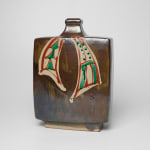Hamada Shoji 濱田庄司 1894-1978
Flat Jar with Persimmon Glaze and Red and Green Enamel, 鐵砂赤絵扁壺
Stoneware
H9" x W6.2" x D3"
H22.8 x W15.7 x D7.6 cm
H22.8 x W15.7 x D7.6 cm
With Signed Wood Box
Sold
Further images
-
(View a larger image of thumbnail 1
)

-
(View a larger image of thumbnail 2
)

-
(View a larger image of thumbnail 3
)

-
(View a larger image of thumbnail 4
)

-
(View a larger image of thumbnail 5
)

-
(View a larger image of thumbnail 6
)

-
(View a larger image of thumbnail 7
)

-
(View a larger image of thumbnail 8
)

-
(View a larger image of thumbnail 9
)

-
(View a larger image of thumbnail 10
)

-
(View a larger image of thumbnail 11
)

-
(View a larger image of thumbnail 12
)

-
(View a larger image of thumbnail 13
)

-
(View a larger image of thumbnail 14
)

-
(View a larger image of thumbnail 15
)

-
(View a larger image of thumbnail 16
)

Hamada Shoji was in the initial group of the first four ceramicists to be designated Living National Treasure in 1955, in his case for the preservation of mingei ceramics. Hamada...
Hamada Shoji was in the initial group of the first four ceramicists to be designated Living National Treasure in 1955, in his case for the preservation of mingei ceramics. Hamada needs little introduction as he, and Kawai Kanjiro, became the prime exponents of the mingei tradition that has been both popular and influential inside and outside Japan. Indeed, it is hard to look at post-1945 ceramics without seeing the influence they exerted. Nonetheless Hamada’s work remains significant and he is the true master of form and decoration. The myriad copies of his forms not only attest to his influence but also emphasize just what a master of proportion he was for there is a balance in his work and a harmony of form and decoration that sets it apart.
5
of
5















